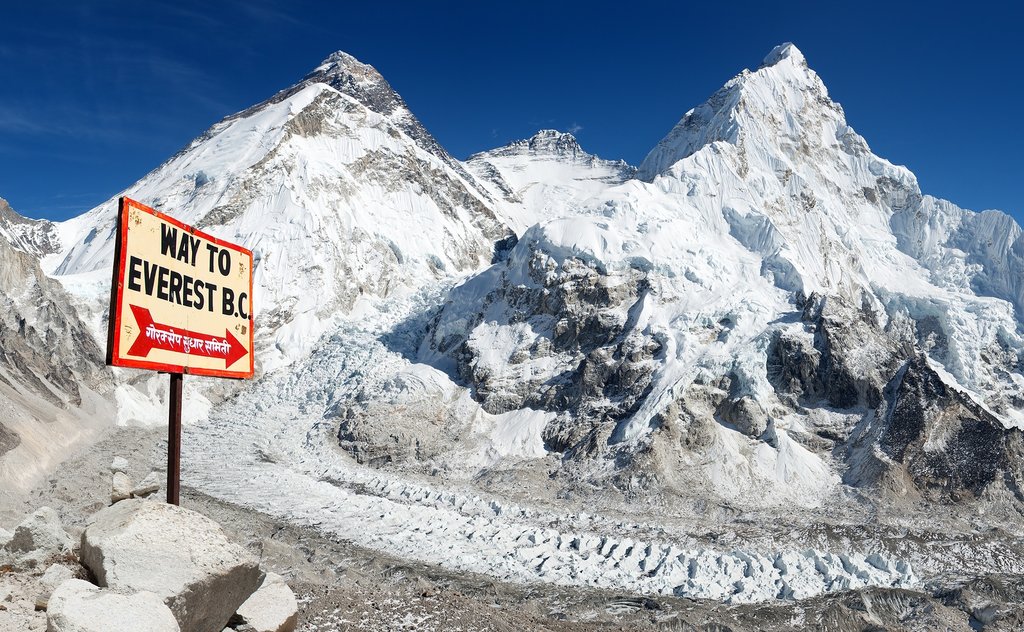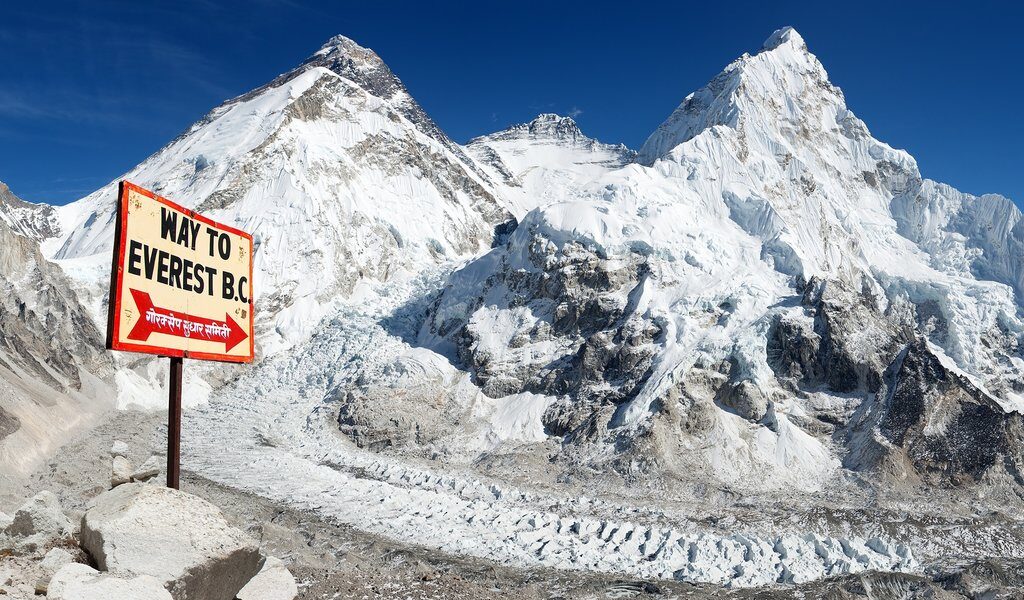
January is firmly in Nepal’s trekking off-season, with low visitor numbers across the country. Kathmandu gets quite cold in the evenings, and it’s even colder up in the mountains at higher elevations. But, if you’re prepared for cold temperatures (and snow!), the clear views and the fact that you’ll have the trails to yourself make this a surprisingly great time to trek through the Everest region.
Weather Conditions in the Everest Region in January
January in the Nepal Himalaya presents a unique set of conditions for trekkers. Rainfall is a rarity during this time, leading to exceptionally clear skies and unparalleled visibility of the majestic mountain ranges. The crisp air and brilliant sunshine create stunning panoramic views, making it an ideal time for photography and appreciating the sheer scale of the landscape. However, it’s essential to remember that snow can fall at any time, particularly at higher altitudes. Even with clear skies predicted, the weather in the mountains can change rapidly, so preparedness is key.
As altitude increases, temperatures will noticeably decrease. This is a crucial factor to consider when planning your trek and packing appropriate clothing. In **Namche Bazaar** (situated at 11,290 feet), average January temperatures fluctuate between a chilly 18°F (-8°C) and a milder 43°F (6°C). While **Namche Bazaar** offers a relatively moderate climate compared to higher elevations, remember that points further along the trail will experience significantly colder conditions. Be sure to consult detailed weather forecasts specific to your planned route and pack layers to adjust to changing temperatures throughout the day. Remember that wind chill can also play a large factor in how cold it feels.
Navigating Crowds and Costs During the Winter Season
Winter represents the low season for trekking in the Everest region, which translates to a significantly more peaceful and solitary experience on the trails. You’ll find it much easier to secure accommodation at the various teahouses along the Everest Base Camp trail and throughout the wider Everest region. Finding an available room is significantly easier in January. The reduced number of trekkers also offers a chance to connect more deeply with the local culture.
However, a word of caution: some teahouses, especially those situated at higher elevations, may be closed during this period. Many local inhabitants of these high-altitude settlements traditionally migrate to Kathmandu for the winter months. This annual migration reduces the availability of services and supplies in some areas. This is a significant reason why trekking with a knowledgeable guide is particularly beneficial during January. Local guides possess invaluable insights into which establishments remain open and operational throughout the off-season, ensuring you have access to food and shelter.
While the fundamental costs of accommodation, food, and transportation are generally consistent throughout the year, the significantly reduced number of travelers in January can create opportunities for better value for money. During peak season, flights to Lukla and desirable teahouses are in high demand and book up well in advance. Consequently, without early reservations, you might not secure your preferred flight times or might be forced to settle for less desirable accommodation options, potentially paying the same price as higher-quality alternatives. However, in January, this is much less likely to occur, as options are more readily available.
The trails in the Everest region become significantly less congested in January compared to the peak months of October and April. This offers a unique opportunity to experience the breathtaking scenery in relative solitude. Considering that the EBC trek is Nepal’s most popular and often crowded trek, this reduction in visitor numbers can profoundly enhance your overall experience, allowing for a more intimate connection with the mountains.
Recommended Trekking Routes and Considerations for January
Certain higher-elevation treks may not be suitable or advisable during January due to the combination of cold temperatures and potential snowfall. Some routes can become completely impassable due to heavy snow accumulation. Treks that involve crossing high mountain passes, such as the challenging Three Passes Trek, are generally not recommended during this period, as these passes are likely to be heavily snowbound and pose significant safety risks.
It is crucial to understand that even on seemingly suitable routes, conditions can change rapidly. You should be prepared to turn back at any point along your chosen route if the weather deteriorates unexpectedly and your experienced guide deems it unsafe to proceed further. Prioritizing safety is paramount when trekking in the mountains, especially during the winter months.
However, it’s important to note that trekking in January doesn’t automatically guarantee the necessity of turning back. Snowfall patterns are unpredictable, and routes may become impassable either earlier or later in the season, depending on specific weather conditions. Treks that primarily stay below 13,000 feet are generally more comfortable and safer during January. Nonetheless, even at these lower altitudes, it remains essential to closely monitor weather conditions and heed the advice of your guide as you progress along the trek.
If you are not a highly experienced trekker confident in handling cold temperatures at high altitude, consider a shorter trek in the Everest region. Opting for a route that doesn’t reach Everest Base Camp can be a prudent choice. By trekking to and establishing a base in **Namche Bazaar**, approximately a two-day walk from Lukla, you can enjoy a variety of day hikes in the surrounding area. The views from **Namche Bazaar** are particularly spectacular during this time of year, and you’ll be at a lower risk of experiencing altitude-related or temperature-related issues compared to higher elevations.
Another attractive alternative is to embark on the “Pioneers’ Route” from Jiri to Lukla. This route holds historical significance as it was the original trekking trail used by early Western mountaineers to access the Everest region before the construction of the airport in Lukla. Jiri is accessible via a day’s drive from Kathmandu. Alternatively, you can fly from Kathmandu to Phaplu and then trek through the Solukhumbu region from there. Fewer trekkers choose this route these days, which presents an opportunity to experience a unique culture that contrasts markedly with the Sherpa culture prevalent at higher altitudes. These treks typically take between 4 and 7 days, depending on the specific route chosen. Upon reaching Lukla, you could continue onward to **Namche Bazaar** and use it as a base for exploring the surrounding area through day hikes.
January is also an excellent time to indulge in a more luxurious trekking experience. Travelers seeking added comfort and willing to invest a bit more can enjoy the exceptional hospitality and amenities offered by some of the Everest region’s finest lodges, such as Yeti Mountain Homes and Everest Summit Lodges. While a luxury trek is a special experience at any time of year, it becomes even more appealing in winter. After a day of trekking in the cold, you can retreat to a warm and comfortable hotel that rivals boutique accommodation found in major cities.
Essential Items to Bring for Trekking in January
Proper preparation for the cold weather is crucial for both your comfort and safety when trekking in January. While many teahouses provide blankets, these might not be sufficient to withstand the harsh winter conditions. Investing in a high-quality sleeping bag designed to keep you warm in temperatures as low as -30°C is highly recommended.
Although the sun can provide some warmth during the day, you’ll still need to wear warm clothing while trekking at higher altitudes. A warm down jacket is an ideal choice due to its lightweight nature. This allows you to easily pack and carry it in your bag if you need to remove it during the day without being burdened by excessive weight. Warm clothing for the evenings and nights is also essential. Remember to pack good woolen hats, gloves, socks, and scarves to protect yourself from the cold.
If you lack your own winter trekking gear or don’t anticipate needing it at home, you can conveniently purchase or rent almost all necessary winter equipment from trekking shops located in Kathmandu.
Transportation Options to and from the Everest Region
The fastest route to the Everest region is by flying from Kathmandu to Lukla. While January generally experiences fewer rain-related delays and cancellations compared to other months, Kathmandu is prone to experiencing fog during the winter season. This fog has the potential to disrupt flights to and from Lukla, even if the weather conditions in the mountains are otherwise favorable. Stay abreast of weather updates to ensure you have the latest information regarding transportation to and from the region.
Festivals and Events in January
Imagine celebrating New Year’s Eve amidst the stunning Himalayan scenery – a trek in the Everest region could provide an unforgettable experience! If you are hoping to experience the nightlife and visit the local bars, aim to be in **Namche Bazaar** on December 31st to enjoy the New Year festivities. Be mindful that the effects of alcohol can be amplified at higher altitudes.
Traditional Nepali festivals, encompassing both Hindu and Buddhist celebrations, typically follow a lunar calendar, which means that the dates can shift from year to year. One festival that often occurs in January is Lhosar. This significant Buddhist festival marks the new year for Nepali ethnic groups with Tibetan ancestry, most notably the Gurung, Tamang, and Sherpa people. Given that a significant portion of the Everest region’s population consists of Sherpas, traveling during Lhosar might offer the opportunity to witness or participate in some of the local festivities.
Suggested Trekking Itineraries for January
Best Winter Treks in Nepal
Luxury Everest Heli Trek – 4 Days
Namche Bazaar Trek – 7 Days
Tengboche Monastery Trek – 10 Days
Dingboche Trek – 12 Days
Additional Resources and Information
Nepal in January: Travel Tips, Weather, and More
Everest Base Camp in December
Everest Base Camp in February
Domestic Flights in Nepal
B-1718

